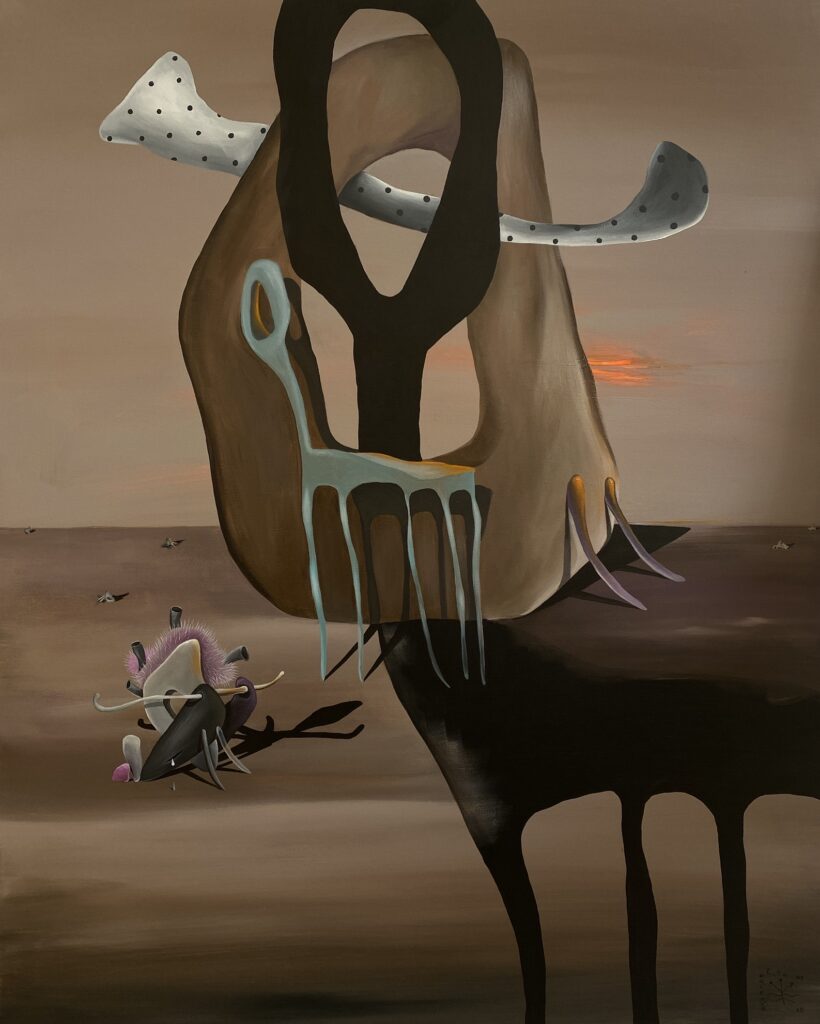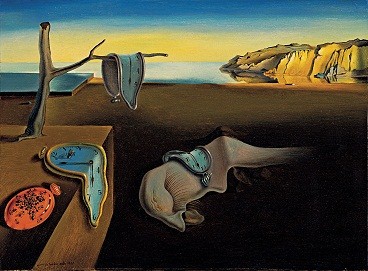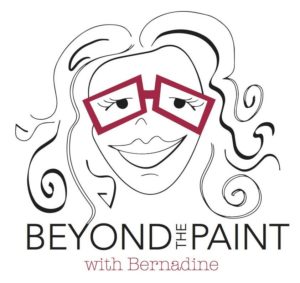Join me in a conversation and exploration of the Surrealist contemporary painter of Ukraine, Rita Maikova. Her fantastical paintings express the interior of her mind and spirit, “all the parts of me,” says Maikova. Infused with feminine and maternal energy, Maikova’s works and practice are informed by the Surrealist aesthetic, Ukrainian folklore embedded with personal iconography and symbols.
.
Currently, Maikova is exhibited at the Sapar Contemporary Art Gallery in “Women and Other Wild Creatures: Matrilineal Tales” until August 26, 2022.
.
Learn more about Rita Maikova: IG handle @ritamaikovaart: Twitter: @rmaikova1
Podcast Episode Image: “Magic Forest,” oil on canvas, 2022


Other works highlighted in the episode:

Script:
Welcome my art enthusiasts. Today join me into the visual world of contemporary painter of Ukraine: Rita Maikova; her visual language of symbols, her works, a culmination of Surrealism and Ukrainian folklore embedded with her personal visual language of symbols and iconography. Before you join me in a conversation with the artist; she is currently in London, let’s spend a moment on a couple of art terms, specifically Surrealism. Surrealism is a (Great Women Artists): artistic and literary movement prominent from the 1920s onwards, with continued influence today, which sought to explore the unconscious mind; artists sought to channel the unconscious as a means to unlock the power of the imagination. Surrealists produced fantastical, disturbing and sometimes humorous works of art, using many styles and media, including found objects and hyper realistic paintings and manipulated photography. It was especially influential in France, Britain, Mexico and South America.
Even though Surrealist imagery is very recognizable, it is difficult to define it through one iconic work of art. “Each artist relied on their own recurring motifs arisen through their unconscious mind. Nature is a frequent imagery—Max Ernst, for example, was obsessed with birds, Salvador Dali, included ants and eggs in his compositions. “The Persistence of Memory,” an iconic small piece from 1931 by Dali is comprised of melting pocket watches; one is drooped over a tree branch, in the background, a barren landscape of yellow mountains meeting a bright sunlight on the horizon. Surrealist artist Joan Miro experimented and composed canvases with non-figural, abstract forms, called biomorphic forms. Biomorphic forms or images are ones that while abstract nevertheless refer to, or evoke, living forms such as plants and the human body. In the 1933 oil on canvas work, titled, “Painting,” the Spanish artist Miro composes on his large scale work “fragments of figures and creatures, all composed of delicate lines using minimal color; the forms swim and drift weightlessly before a dark-stained background. Miro evoked a lyrical dream world with forms that seemingly flowed automatically from his hand.
Maikova working in the Surrealist aesthetic brings to the canvas her Ukrainian roots, and her culture’s folklore and like Miro, composes biophoric forms in her prolific works. A self proclaimed explorer, seeker, scientist “sees in her art as an endless dialogue between the soul and the universe.” In her practice Maikova enters into the place of “meditative stillness,” investing in mindfulness and the present—within this invested, mindful space, she composes works that “progress between the conscious and unconscious mind.” The result is canvases that engage and provoke, dare I say jolt the imagination of the viewer.
Before you join me in my conversation with Maikova, let’s journey through 3 paintings, these works will be referenced in our talk. I want you to have visual context as we dive into the paintings with the artist, each represents themes Maikova and I will explore that are prominent in her work.
1. “Magic Forest” oil on canvas from 2022: Ukrainian Folklore. I saw this painting in person at the Sapar Contemporary Art Gallery in New York. Magic Forest is part of the exhibition, “Women and Other Wild Creatures: Matrilineal Tales,” a group exhibition of women artists who draw strength from the connection with non-human nature, involving it in their healing practices and increasingly fantastical visions of human unity with nature. The show includes artists dominantly from the Ukraine. The show, curated by Nina Levent is up until August 26. I will add links to the podcast show notes.
In the painting “Magic Forest,” Rita composes a magical forest, a surrealist landscape that artist describes as infused with feminine and maternal energy and inhabited by a folk character Podolyanochka. Podolyanochka is a spirit that fills everything with color, strength and vibrancy. Maikova describes the work as ““A forest where little creatures live in their homes, sleep in their beds. Every night a fluffy angel flies to them and keeps their sleep safe. It is warm, cozy and very soft in this forest; life flows calmly and harmoniously in this forest. Fountains scatter drops of freshness that tickle the fluffy thickets. Trees serve as a support and reliable protection for everyone who needs a home.
And even if I and many of us don’t have a home right now (the artist references the Russian invasion of the Ukraine earlier this year)… we have the Feeling of Home, and we will scroll through this warm feeling more and more often and at one moment we will realize that we are sitting in a comfortable chair with a cup of tea and a book in Our New Home. And even though it is not physically there, it exists when we close our eyes! The Home is being built inside us”
What strikes me about Magic Forest is the vibrancy of the colors, the sense of intimacy between the forms—my favorite biomorphic form, Maikova calls “dark rabbit,” appears like an open cocoon on thin stilted legs. Within are curved disc-shaped forms that listlessly droop and coddle in and around the “cocoon.”
Around the theme of “shadow” Maikova and I will reference her acrylic painting titled “Shadow.” A landscape work, with a defined horizon line, we can see streams of a bright, orange sun. The entire landscape is a deep brown, barren. In the foreground on four legs appears to be an animal like creature, his figure is flattened, the upper part of his body, the head, is composed of two square shapes that intertwine within each other and sticking through the openings is a white with a splattering of dots, an uneven oblong shape, it reminds me of a bone. Behind the dominant figure in the foreground, another creature appears like a large beetle with a bristle of hair, painted bright lavender.
The last painting, emulating the theme of symbolism in Maikova’s works is an oil painting, Finca Arobona. Maikova describes the painting, “very close to my heart. It’s about the place that became our home, a place to which we will return with the warmest feelings. I write this with tears in my eyes. This painting is in safe hands and I am very happy about it. Composed on a vertical canvas, this work appears to embrace a narrative. Your eye follows a compilation of forms and recognizable objects, like a flowing piece of drapery. One object flows or is connected to another a rounded purple handle holds a table like object, atop is the flowing drapers and just below into an open vessel, the legs of the table transform into open bud-like forms; a yellow liquid flows into the vessel in big droplets. The palette is browns and vibrant purplish hues. Each form is a personal symbol of Maikova’s visual language exposing her personal experiences, her narrative of place. It is breathtaking.
I hope my descriptions of three of Maikova’s paintings give you a sense of the depth and breadth of this young woman’s work. So please join me in a conversation with the artist Rita Maikova.
